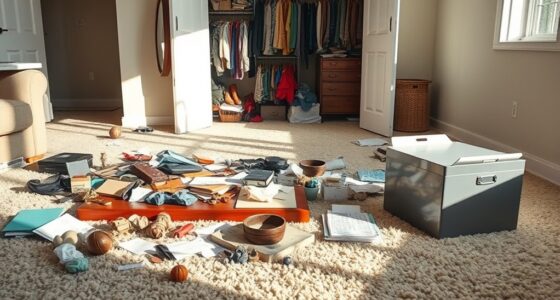Clutter weighs you down, affecting your focus and mental health. By decluttering your space, you can lower stress and boost productivity. Start by setting realistic goals and tackle one room at a time. Use sorting containers to categorize items and apply the 12/12/12 Rule for systematic removal. Letting go of emotional attachments is tough, but it's essential for creating a peaceful environment. Discover more practical strategies to maintain a clutter-free home and embrace this refreshing lifestyle.
Key Takeaways
- Set realistic decluttering goals and tackle one room at a time to maintain focus and momentum.
- Use sorting containers to categorize items into keep, donate, recycle, and discard for an organized approach.
- Apply the 12/12/12 Rule by removing 12 items to keep, 12 to donate, and 12 to discard regularly.
- Document stories behind sentimental items to help detach emotional value and make decluttering easier.
- Establish weekly decluttering habits and use shopping lists to avoid impulse purchases and maintain an organized space.
Understanding the Impact of Clutter on Your Life
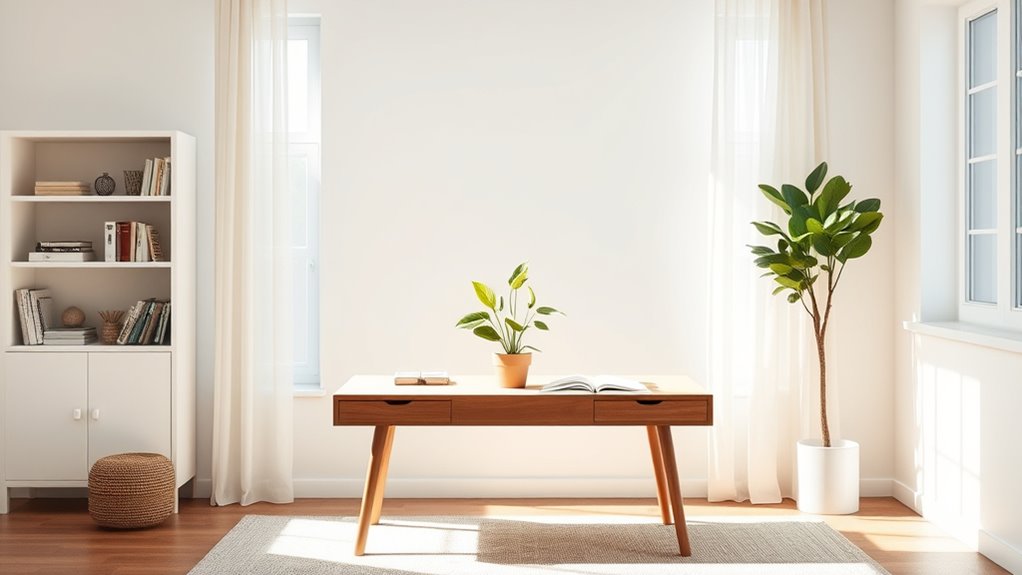
As you navigate your daily life, clutter can silently undermine your well-being in various ways. It can reduce your focus, causing cognitive overload that makes concentrating a challenge. You might find yourself feeling more stressed, as cluttered spaces have been linked to elevated cortisol levels. Clutter negatively impacts working memory, making it even harder to stay on task and retain important information.
This disorganization can also impair your emotional intelligence, making it harder to read emotional cues from others. Visual reminders of chaos drain your cognitive resources, leading to increased anxiety and even depression in severe cases.
Beyond mental health, clutter can affect your physical well-being, connecting to issues like obesity and allergies. By understanding these impacts, you can better appreciate the need for a more organized, peaceful environment.
The Benefits of Decluttering Your Space
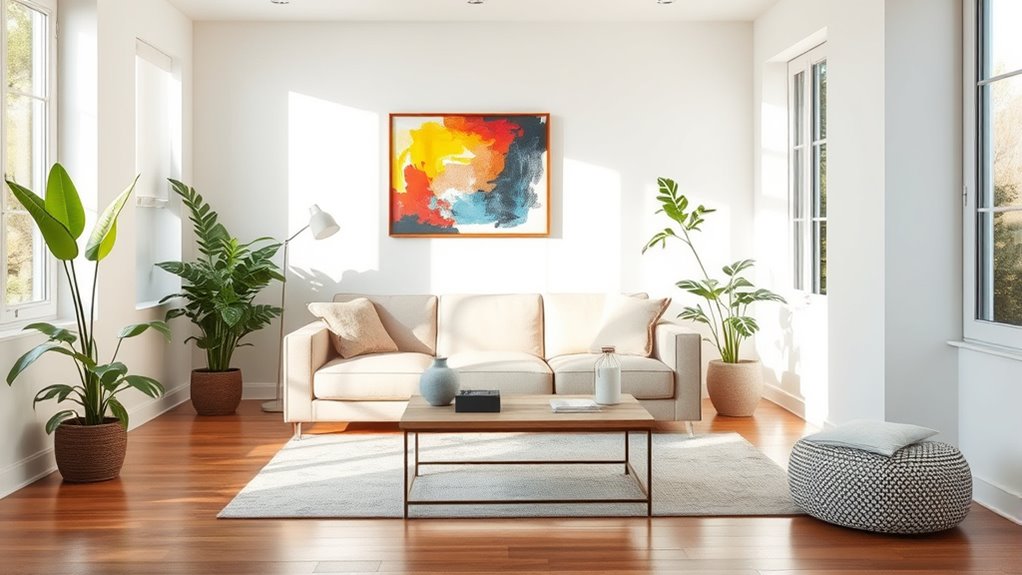
Decluttering your space offers a multitude of benefits that can significantly enhance your overall well-being.
It reduces stress and anxiety by creating a calming environment, allowing you to focus better and boost your productivity. When you take control of your surroundings, you'll likely experience an increase in self-esteem and creativity. Additionally, decluttering promotes better sleep by creating a clutter-free environment, which can lead to more restorative rest. Regularly assessing and rotating items in your space can further contribute to maintaining a serene atmosphere.
A clean, organized space can also improve your sleep quality, promoting better rest. Physically, decluttering reduces asthma and allergy risks, while encouraging more movement during the process itself.
It creates a healthier living environment that's easier to maintain. Plus, as you simplify your life, you'll save money by avoiding unnecessary purchases and storage costs, ultimately leading to a more efficient, fulfilling lifestyle.
Trends in Decluttering: What You Need to Know
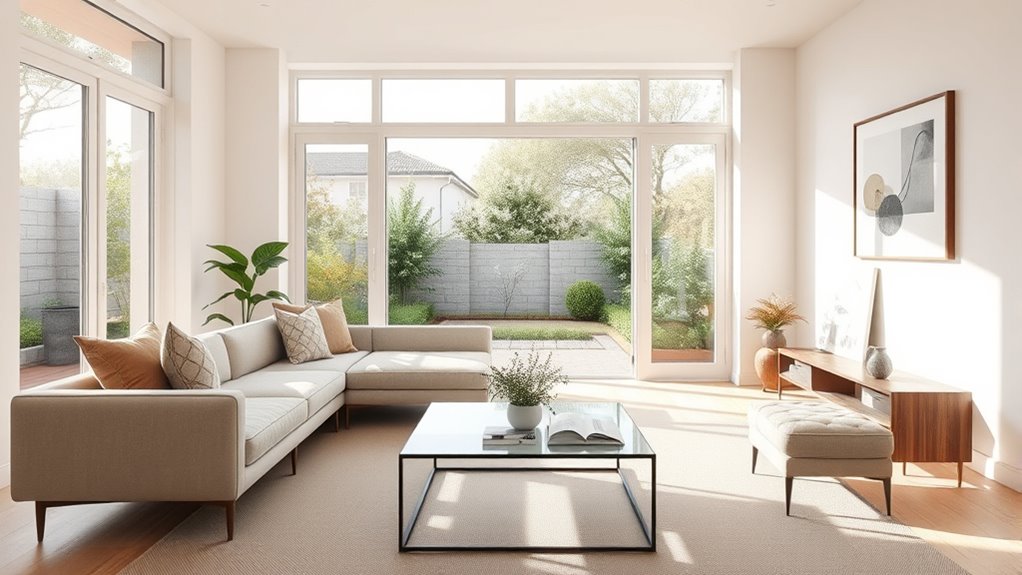
What trends are shaping the decluttering movement today?
First off, individualized approaches are gaining traction, allowing you to tailor methods to fit your lifestyle. Additionally, individual intuition is encouraged during the decluttering process, helping you trust your instincts and create a home that truly reflects your needs. Kid-friendly practices are also on the rise, helping children develop essential decluttering skills. Virtual consultations are becoming popular, offering guidance from the comfort of your home. Sustainability plays a significant role too, with a focus on eco-friendly methods like repurposing and recycling. Incorporating elderly care strategies can further enhance the decluttering process, ensuring that spaces are safe and functional for all ages. Digital decluttering is key for mental clarity, emphasizing the importance of organizing your online spaces. Lastly, social media influencers are promoting decluttering as an aesthetic choice, inspiring you to create bespoke storage solutions. Embracing these trends can make your decluttering journey more effective and enjoyable!
Practical Tips for Effective Decluttering

Embracing the latest trends in decluttering can set the stage for a more organized life, but practical strategies are what truly drive results. Start by setting realistic goals; break tasks into manageable segments to avoid feeling overwhelmed. Use sorting containers to categorize items into keep, donate, recycle, and discard. Focus on one room at a time to maintain your momentum. Begin by removing trash and recyclables to instantly clear clutter. Incorporating the 12/12/12 Rule can simplify the decluttering process by providing a clear framework for removing items from your home. Additionally, consider the benefits of regularly trimming your cat's nails to reduce scratches on your furniture, making your space feel more polished and organized. Create a checklist to prioritize tasks and ensure consistency. Essential tools like laundry baskets, drawer organizers, and wall mount holders can help streamline your efforts. Finally, implement effective rules like the 12/12/12 Rule to make decluttering feel achievable and even enjoyable.
Emotional Attachments: Letting Go of Sentimental Items
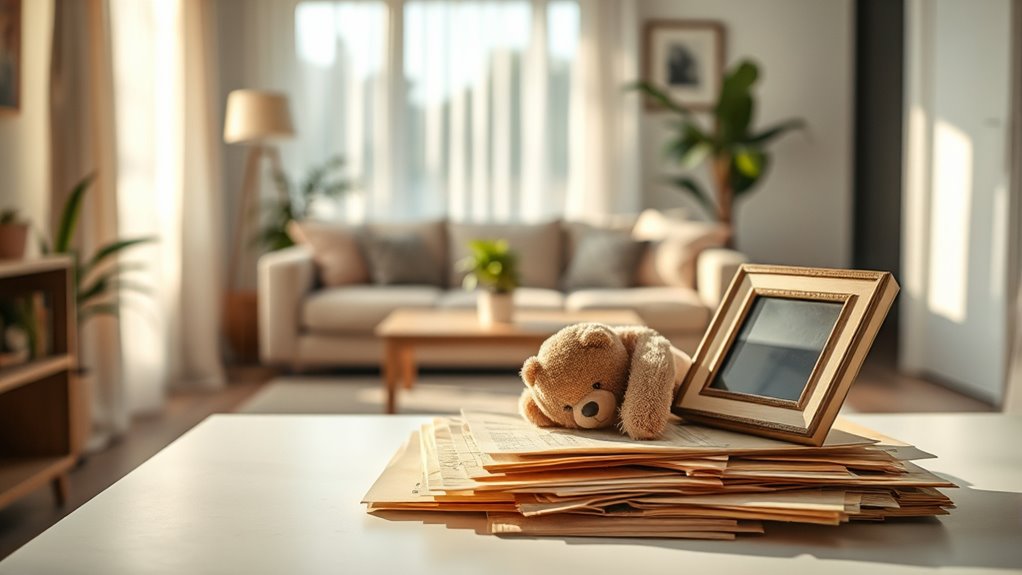
Emotional Attachments: Letting Go of Sentimental Items
Although letting go of sentimental items can be one of the toughest aspects of decluttering, it's essential for creating a more organized living space. Start by understanding that these items often hold emotional weight, making it challenging to decide what to keep. Begin with less emotionally charged objects to build confidence. Document the stories behind your cherished items; this can help you detach their emotional value from the physical object. Many individuals find it difficult to let go of sentimental items due to the emotional ties that create clutter in our lives.
Set boundaries on what you keep, allowing time and space for the process. Consider repurposing or donating items to give them new life, and remember that memories can be preserved through photos or stories. Accepting that memories remain even without the physical items is key to letting go.
Creating a Daily Tidy Routine
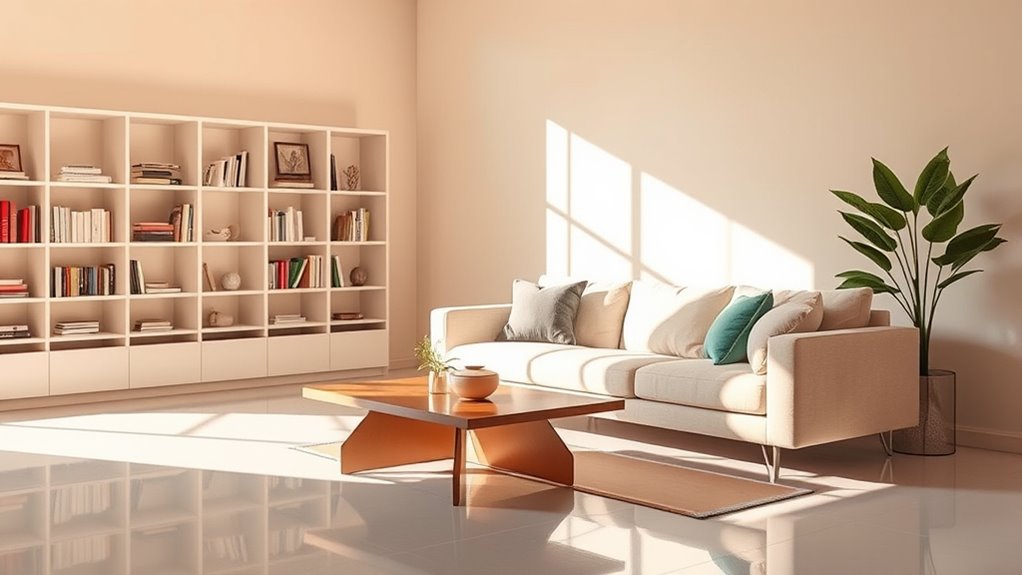
Creating a daily tidy routine can transform your living space into a more organized and peaceful environment. Start by allocating specific times each day for tidying, whether it's in the morning or evening. Focus on high-impact areas like your living room and kitchen first. Use efficient tools like all-purpose cleaners and microfiber cloths for quick cleanups. Regularly collect and dispose of trash to keep clutter from building up. Remember, flexibility is key—adjust your routine as needed based on your daily schedule. Effective reduction of allergens can significantly enhance the efficiency of your routine. Commit to daily decluttering tasks, even if it's just for a few minutes. Incorporating a 3-minute living room tidy-up can significantly enhance the efficiency of your routine.
Room-by-Room Decluttering Strategies
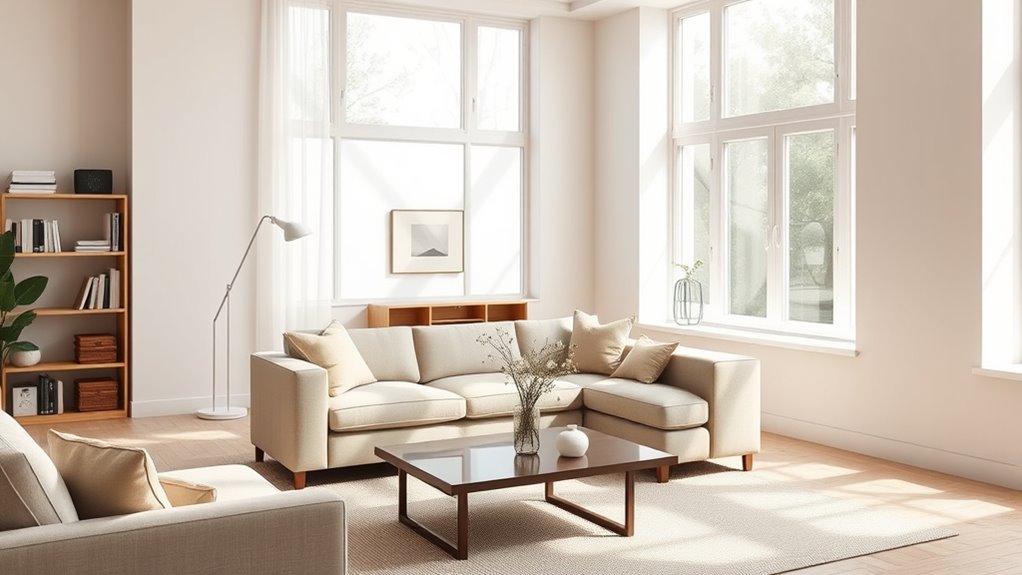
When you tackle decluttering room by room, you'll find it easier to manage your space and create a more organized home.
Start with the most cluttered or frequently used room, setting specific time blocks for each session. Use bins to sort items into categories like donate, recycle, or throw away.
Begin your decluttering journey in the messiest room, utilizing timed sessions and bins for effective sorting.
Focus on high-clutter areas, such as countertops and floors, and clear surfaces in your living room for a fresh look. In the kitchen, assess unused appliances and keep counters clear. Decluttering one room at a time can help you maintain focus and make the process feel more manageable, while also promoting a healthier lifestyle by supporting cleanliness and hygiene.
For bedrooms, sort one drawer at a time and use dividers in closets. Don't forget to manage toiletries in the bathroom and keep laundry areas clutter-free.
Set realistic goals to keep you motivated throughout the process.
Long-Term Maintenance for a Clutter-Free Home

To maintain a clutter-free home, it's essential to establish consistent habits that keep clutter at bay. Set aside dedicated time each week for decluttering tasks and make a habit of putting things back in their place. Implement daily resets to tidy up and prepare your home for the next day. Regularly check for clutter hotspots, addressing them promptly to prevent buildup. Utilize effective storage solutions like bins and labeled containers to keep belongings organized. Consider drop baskets in main rooms for items that need to be put away. Remember, decluttering is an ongoing process as you work to adjust your mindset to view it as a lifestyle choice, and involve family members to foster shared responsibility. Emotional growth often accompanies the journey towards a more organized space, so celebrate small victories to stay motivated!
Intentional Shopping to Prevent Future Clutter

Many people find that intentional shopping is a powerful tool in the fight against clutter. By creating shopping lists with apps like Any.List or Apple Notes, you can avoid impulse purchases. Maintaining a wish list for non-essential items helps you prioritize what you truly need. Set aside a special budget for these purchases to keep your finances in check. Familiarizing yourself with the returns process for online purchases can also help in making more mindful decisions. Additionally, consider the benefits of professional cleaning services for maintaining a clutter-free environment, which can enhance your overall living space.
Be cautious about sales; only take advantage of them for planned items. Instead of buying when bored, consider enjoying the shopping experience without purchasing. Implementing a 24-hour cooling-off period can curb impulse buys, while repurposing existing items or borrowing can keep clutter at bay.
The Mindset Shift: Embracing a Clutter-Free Lifestyle

Embracing a clutter-free lifestyle starts with recognizing the mindset that contributes to clutter in the first place. Negative emotions, like fear or overwhelm, often lead to accumulation. You might struggle to let go of items because of their sentimental value or a scarcity mindset that encourages hoarding. Acknowledging these feelings is essential for change. By shifting your perspective, you can reduce stress and enhance focus in your environment. Adopt positive mindsets such as acceptance and growth, and set healthy boundaries when deciding what to keep. Engaging in community or group activities can contribute to a more positive outlook on life by providing support during your decluttering journey. Reducing clutter can contribute to a more positive outlook on life.
Frequently Asked Questions
How Do I Know When to Declutter an Item?
You know it's time to declutter an item when you haven't used it in over a year or if it's expired or damaged.
If you have duplicates of something that serves the same purpose, consider letting go of the extras.
Also, reflect on whether the item sparks joy or serves a purpose in your life.
If it doesn't, it might be time to donate, sell, or toss it.
Can Decluttering Improve My Relationships?
Yes, decluttering can definitely improve your relationships.
When you clear out physical clutter, you reduce stress and create a more peaceful environment. This calmness helps you communicate better and fosters deeper connections with your partner.
You'll find it easier to focus on conversations without distractions, and your home can become a space for shared experiences, rather than a source of tension.
Ultimately, a tidier space can lead to a happier, healthier relationship.
What Are Some Quick Decluttering Hacks for Busy People?
If you're busy, quick decluttering hacks can help you maintain order without a huge time commitment.
Try the 10-minute rule—set a timer and tackle a small area. Use donation boxes to collect items daily, and implement the one-in, one-out rule when you buy something new.
Organizing your digital life is essential too; delete old emails and unsubscribe from newsletters.
How Often Should I Reassess My Belongings?
When it comes to reassessing your belongings, it's best to strike while the iron's hot.
You should aim for daily micro-decluttering to keep things manageable.
Schedule weekly reviews to ensure you're making consistent progress.
Monthly evaluations can help identify areas needing more attention, and don't forget those seasonal overhauls!
What Should I Do With Items I Can't Decide On?
When you can't decide what to do with certain items, create a decluttering outbox for temporary storage.
Seal and label a box with a date six months ahead—if you don't miss anything by then, it's time to let it go.
Recognize any emotional attachments and sort items into categories, making decisions easier.
Use the 90/90 rule to evaluate whether you've used an item recently and if you'll use it soon.
Conclusion
By embracing these decluttering tips, you're not just tidying up your space; you're transforming your life into a serene sanctuary. Imagine living in a home so organized that it feels like a luxurious retreat every day! Remember, maintaining a clutter-free environment takes commitment, but the rewards are priceless. As you adopt this intentional lifestyle, you'll find clarity, peace, and a renewed sense of purpose in every corner of your life. Start today and feel the difference!



